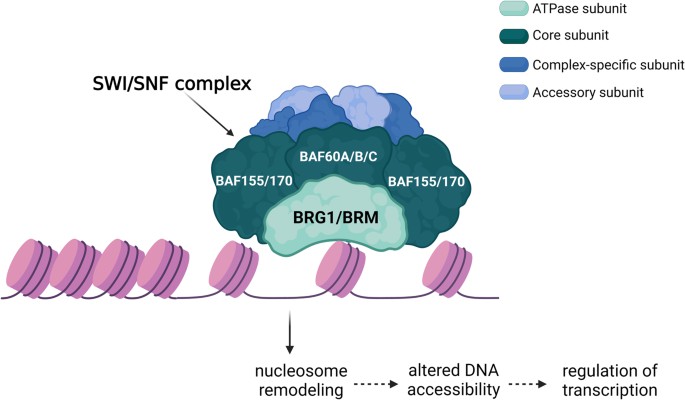What is SMARCA4 Protein
The SMARCA4 gene, also known as BRG1 or SNF2β, delivers instructions for generating a crucial component of the SWI/SNF chromatin remodeling complex called SMARCA4 (SWI/SNF Related, Matrix Associated, Actin Dependent Regulator of Chromatin, Subfamily A, Member 4). The discovery of SMARCA4 protein goes back to the early 1990s, primarily credited to the diligent research efforts aimed at uncovering the mystifying elements of DNA-packaging proteins, histones and their role in gene regulation.
The Gene Locus and Protein Structure
The SMARCA4 gene is located on chromosome 19p13.2, and spans about 58 kb, comprising of 38 exons. The SMARCA4 protein, a 180-kDa protein, is a member of the SWI2/SNF2 family and comprises two major domains, the ATPase and bromodomain, vital for its functionality. The ATPase domain enables energy utilization for chromatin remodeling, whereas the bromodomain enables the protein to bind to certain structures in the chromatin.
Function of SMARCA4 Protein
The primary role of the SMARCA4 protein involves remodeling chromatin, the complex of DNA, and histone proteins that constitute chromosomes. Chromatin remodeling is integral in controlling the accessibility of the underlying DNA to the machinery required for critical cellular processes like transcription, repair, recombination, and replication. Part of the larger SWI/SNF complex, the SMARCA4 protein reshapes chromatin by disrupting the stable interactions between histones and DNA, mainly through ATP hydrolysis.

Fig1. The role of chromatin remodeler SMARCA4/BRG1 (Navickas, S. M., et al. 2023)
SMARCA4 Protein Related Signal Pathway
The SMARCA4 protein predominantly participates in the SWI/SNF signaling pathway, involved in transcriptional activation, cell cycle control, and probable tumor suppression. It functions in signal transduction pathways that regulate cell proliferation, differentiation, and apoptosis, essentially orchestrating cellular responses to a myriad of signals.
SMARCA4 Protein Related Diseases
The aberrant expression or mutations of the SMARCA4 gene can lead to several diseases. Researchers have discovered that loss-of-function mutations in the SMARCA4 gene are associated with certain types of cancer, including lung cancer, ovarian carcinoma, pancreatic carcinoma, and pediatric cancers. Additionally, there's evidence suggesting an association between SMARCA4 gene mutations and Coffin-Siris Syndrome, a rare genetic disorder that primarily affects physical and intellectual development. However, more research is required to conclusively establish the links.
Applications of SMARCA4 Protein in Biomedicine
The understanding of the role of SMARCA4 protein in disease pathogenesis has paved the way for novel therapeutic interventions. In the realm of biomedicine, scientists have been experimenting with the use of gene therapy to replace or repair the malfunctioning SMARCA4 gene. Moreover, it's being investigated as a potential biomarker in the diagnostic process for certain malignancies, providing a promising avenue for early cancer detection.
Furthermore, targeting the SMARCA4 protein with small molecule inhibitors has shown potential in preclinical studies, particularly in cancer types where the SWI/SNF pathway is disrupted. However, translation of these findings into clinical practice warrants more comprehensive investigation.
In summary, the SMARCA4 protein plays an influential role in various biological mechanisms through chromatin remodeling, and its dysregulation can contribute to disease development. The ongoing research into this vital protein's function, the impact of its mutation, and strategies to counteract such changes reflect the importance of the SMARCA4 protein and hold promise for advancing disease prevention, diagnosis, and therapy.
Our Featured Products
| Cat.No. | Product Name | Species | Source (Host) | Tag |
|---|---|---|---|---|
| SMARCA4-2804H | Recombinant Human SMARCA4, GST-tagged | Human | E.coli | GST |
| SMARCA4-198H | Recombinant Human SMARCA4 Protein, His-tagged | Human | E.coli | His |
| SMARCA4-01H | Recombinant Human SMARCA4 Protein, FLAG-tagged | Human | Insect Cells | FLAG |
| SMARCA4-72H | Active Recombinant Human SMARCA4, His&FLAG-tagged | Human | E.coli | His/Flag |
| SMARCA4-1019H | Active Recombinant Human SMARCA4 | Human | Sf9 Insect Cell | N/A |
| SMARCA4-8461M | Recombinant Mouse SMARCA4 Protein, His (Fc)-Avi-tagged | Mouse | HEK293 | His (Fc)-Avi |
| SMARCA4-15R | Recombinant Rat SMARCA4 Protein, His-tagged | Rat | E.coli | His |
Reference
- Navickas, S. M., Giles, K. A., H., K., & Taberlay, P. C. (2023). The role of chromatin remodeler SMARCA4/BRG1 in brain cancers: A potential therapeutic target. Oncogene, 42(31), 2363-2373. https://doi.org/10.1038/s41388-023-02773-9

